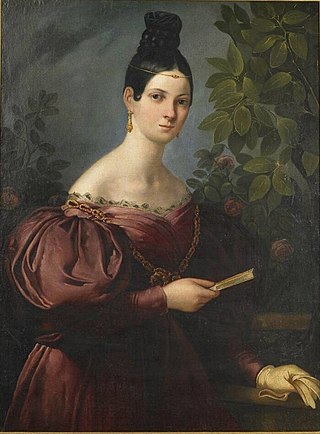
Giovanni Pacini was an Italian composer, best known for his operas. Pacini was born in Catania, Sicily, the son of the buffo Luigi Pacini, who was to appear in the premieres of many of Giovanni's operas. The family was of Tuscan origin, living in Catania when the composer was born. He served as the Florence Conservatory's first director from 1849 through 1862.

Maria Callas was an American-born Greek soprano and one of the most renowned and influential opera singers of the 20th century. Many critics praised her bel canto technique, wide-ranging voice and dramatic interpretations. Her repertoire ranged from classical opera seria to the bel canto operas of Donizetti, Bellini, and Rossini, and further to the works of Verdi and Puccini, and in her early career to the music dramas of Wagner. Her musical and dramatic talents led to her being hailed as La Divina.

Norma is a tragedia lirica or opera in two acts by Vincenzo Bellini with libretto by Felice Romani after the play Norma, ou L'infanticide by Alexandre Soumet. It was first produced at La Scala in Milan on 26 December 1831.

La sonnambula is an opera semiseria in two acts, with music in the bel canto tradition by Vincenzo Bellini set to an Italian libretto by Felice Romani, based on a scenario for a ballet-pantomime written by Eugène Scribe and choreographed by Jean-Pierre Aumer called La somnambule, ou L'arrivée d'un nouveau seigneur. The ballet had premiered in Paris in September 1827 at the height of a fashion for stage works incorporating somnambulism.

Maria Felicia Malibran was a Spanish singer who commonly sang both contralto and soprano parts, and was one of the best-known opera singers of the 19th century. Malibran was known for her stormy personality and dramatic intensity, becoming a legendary figure after her death in Manchester, England, at age 28. Contemporary accounts of her voice describe its range, power and flexibility as extraordinary.

Inva Mula is an Albanian opera lyric soprano. She began her soprano career at a very early age. Her father and mother were also opera singers. She is also known for providing the voice of the diva Plavalaguna in the film The Fifth Element.

Virginia Zeani was a Romanian-born opera singer who sang leading soprano roles in the opera houses of Europe and North America.

Giulietta Simionato was an Italian mezzo-soprano. Her career spanned the period from the 1930s until her retirement in 1966.

Fiorenza Cossotto is an Italian operatic mezzo-soprano.
Lucia Aliberti is an Italian operatic soprano singer. She performed the bel canto roles of Bellini, Rossini, Donizetti, Verdi, Puccini, Vivaldi, Mercadante and so on.

Luigia Abbadia (1821–1896) was an Italian operatic mezzo-soprano known for her fine voice, secure technique, and a strong temperament. Possessing an uncommonly wide range, Abbadia sang several roles traditionally portrayed by sopranos in addition to roles from the mezzo-soprano repertoire.

Giuseppina Ronzi de Begnis was an Italian soprano opera singer famous for the roles written for her by the prominent composers of the 1820s and 1830s. Her father, Gaspare, was a prominent ballet dancer and choreographer, and her mother, Antonia, was a ballerina. Her brothers Stanislao and Pollione were opera singers. As a singer, she made her debut in Naples at the Teatro dei Fiorentini in 1814 in Giovanni Cordella's L'Avaro, followed by important engagements in Bologna in 1816, also appearing in Genoa, Florence; in 1817 as Giulia La Vestale, and in Bergamo. She married Italian bass Giuseppe de Begnis (1793–1849) when she was only 16. The marriage lasted only a few years and the two separated in 1825.

Carolina Ferni was an Italian violinist and operatic soprano.
Soprano sfogato is a contralto or mezzo-soprano who is capable — by sheer industry or natural talent — of extending her upper range and encompassing the coloratura soprano tessitura. An upwardly extended "natural" soprano is sometimes called soprano assoluto.

Gioseppa Maria Camilla, commonly known as GiuseppinaGrassini was a noted Italian dramatic contralto, and a singing teacher. She was a celebrity of considerable stature, noted for her beauty and regarded as one of the best singers in Europe. Giuseppina was also known for her affairs with Napoleon and the Duke of Wellington. She sang in various productions by composers such as Cimarosa, Cherubini and Zingarelli.
Elisa Orlandi (1811–1834) was an Italian opera singer who was active at major opera houses in Italy from 1829 until her sudden death in 1834. Possessing a wide vocal range with a significant amount of coloratura facility, she tackled roles from both the mezzo-soprano and soprano repertoires. She is best remembered today for portraying the role of Giovanna Seymour in the world premiere of Gaetano Donizetti's Anna Bolena in 1830.
Hertha Töpper was an Austrian contralto in opera and concert, and an academic voice teacher. A member of the Bavarian State Opera, she appeared in leading roles at major international opera houses and festivals.

Maria Caterina Rosalbina Caradori-Allan was a French operatic soprano.

Angiolina Ortolani-Tiberini was an Italian soprano who sang many leading roles in European opera houses during a career spanning over twenty years. After their marriage in 1858, her career was closely entwined with that of her husband, the tenor Mario Tiberini, with the couple often appearing together on stage. Amongst the roles she created was Ofelia in Franco Faccio's Amleto.

Amalie Schütz known under the stage name Amalia Schütz Oldosi, was an early 19th-century Austrian soprano who performed in Austria, France, England and Italy.



















